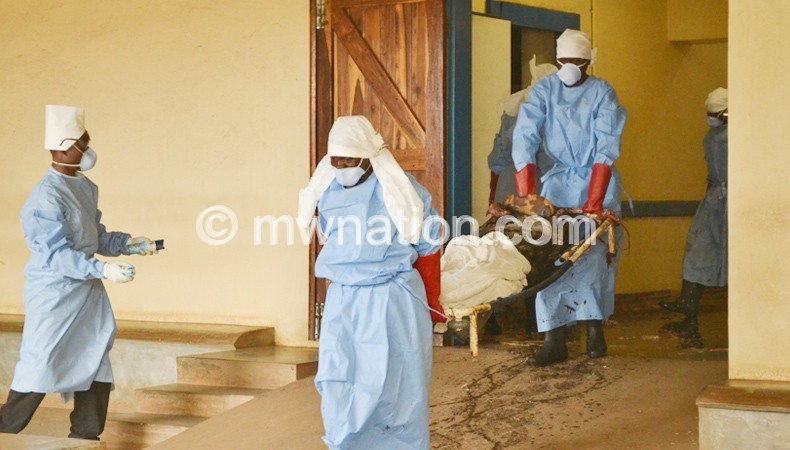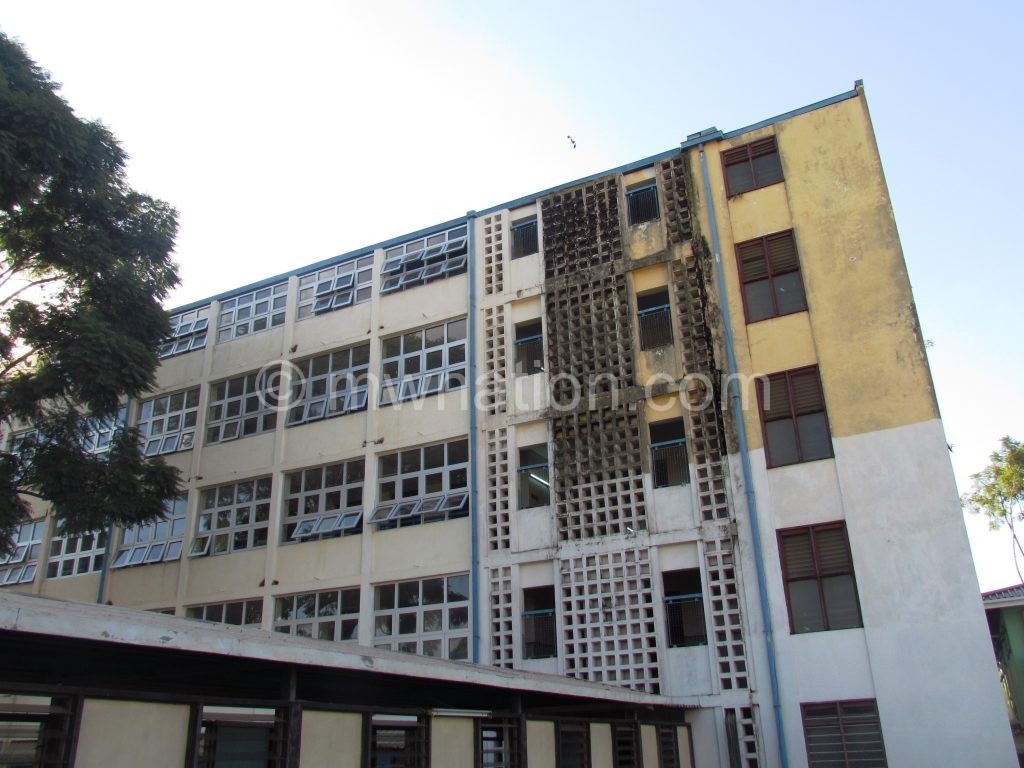Groans of the health care system
- KCH: Face of healthcare in ruins
- Built with bed capacity of 350, admits 1 200
- Requires K200m every month to barely run but gets K70m
It is not just patients in pain. Everything and everyone else is groaning at Kamuzu Central Hospital (KCH) this hot Tuesday morning.
The wards cry out for capacity relief as patients fill every available space.

Nurses groan as their tired and wobbly bones struggle to keep up with 12-hour shifts while struggling to attend to patients several times more than they should.
And the weight of this failed health care giant falls on the sagging shoulders of hospital director Dr. Jonathan Ngoma.
Ngoma’s impassioned plea for help-during an interview in his office-rings hauntingly in this multi-story shell, a shadow of its former self built in 1977.
“When a guardian rushes to call a nurse, we just know there is no life. The patient is gone,” Dr Ngoma says resignedly.

What he means is that most of the times it is guardians who provide frontline care to patients here as nurses are so few to attend to every sick person admitted to the hospital; that three nurses are responsible for the care of close to 80 patients per shift.
Guardians would only call for a nurse if the situation is really dire, even hopeless.
The facility was built to admit 350 patients but bed capacity has exceeded by over 50 percent in the last 20 years.
Picture this: KCH needs K5 billion to have sufficient drugs in the 2016/17 financial year, but Parliament allocated K1.9 billion, a mere 38 percent of the required amount.
When it comes to personnel, this hospital is in a dire situation.
The total number of staff at KCH as at 31 March 2016, stands at 1 194, but there is a high vacancy rate here of specialist doctors, nurses, clinicians and cadres who are tasked with front line assistance to patients.
For example, of the 59 established posts for specialist doctors, only 15 are filled, representing 25 percent or a quarter of the numbers required.
KCH needs 78 medical doctors, but only has 49; it requires 439 nurses, but there are 331, leaving 94 vacancies.
Whereas there are 133 posts for clinicians, only 47 are filled, leaving 86 vacant.
The problem is nationwide, according to the annual economic report for 2016, as there were 4 000 filled posts in the nursing cadre against 13 600 established posts and 161 in pharmacy against 545 established posts.
There were supposed to be 344 medical officers but only 168 posts were filled, 1 600 clinical officers against 4 500 representing a 60 percent vacancy rate.
According to World Health Organisation, the recommended ratio for nurse-patient is 1 to 1 000 but in Malawi it is as high as 1 to 2 300.
The hospital requires K200 million every month to barely run its operations, but gets K70 million, which is just 35 percent of its needs.
Yet, apart from its own operational expenses, it also has to provide referral support to district hospitals in the Central Region, supervising them in some cases using the same money.
The total number of staff at KCH as at 31 March 2016, stands at 1 194, but there is a high vacancy rate here of specialist doctors, nurses, clinicians and cadres who are tasked with frontline assistance to patients.
For example, of the 59 established posts for specialist doctors, only 15 are filled, representing 25 percent or a quarter of the numbers required.
KCH needs 78 medical doctors but has 49 only. It requires 439 nurses but there are 331, leaving 94 vacancies.
There are 133 posts for clinicians but only 47 are filled, leaving 86 vacant.
The situation at KCH defies the universal definition of primary health care, provision of basic curative health services on the basis of community participation and inter-sectoral collaboration.
Congestion is a serious problem and there is lack of both bed space and beds.
Take the scenario at KCH’s male surgical ward 1A. On a normal day, the room built to accommodate four beds has 10. In addition, there are 22 beds on the veranda meant for patients to go out and take in fresh air as part of their healing process.
In the corridors and on the floor are also patients due to lack of bed space.
“When we have one nurse, day or night shifts, we go around and observe patients to see those who need assistance the most. Guardians help us, because they know their patients well. Guardians turn into nurses, sometimes,” a nurse remarks.
On this Tuesday, four nurses are on duty in 1A, providing care to 75 patients. In the female surgical ward, there are three nurses this afternoon looking after 80 patients.
In the children’s ward, the sight of three feverish children lying side by side on one bed and the many guardians leaning over beds, watching their children like hawks shows just how much the system is broken.
. During the rainy season when the hospital registers high numbers of malaria cases, the ward has an average of 190 children , but the number of nurses on duty does not change. It remains four, and at times even two per shift.
“We are used to having few nurses on duty. When it is time to dispense medicines, a nurse stands over there and guardians come and collect them for their patients. If a nurse were to go to every bed to observe every patient, it would be impossible,” Ngoma said.
The ward has no functional nebulizer and when it is working, children queue with their guardians just to breathe easy.
“There are few oxygen concentrators, few thermometers, apart from few nurses. But we are used to having few nurses,” he said.
Commitment, one nurse says, is what makes her get up in the morning to provide services to 56 patients who suffer from chronic kidney failure at the renal unit.
On a daily basis, the unit sees 23 patients who are plugged into the 10 dialysis machines available at the hospital, but only five nurses.
“It is all about commitment and love for my job, otherwise we are overworking here. On average I work 12 hours a day, every day,” she says.
As the hospital’s oncology department awaits the construction of the National Cancer Centre, the country’s second oncologist Richard Nyasosela sees 70 to 80 cancer patients undergoing chemotherapy in a week.
20 to 25 new patients in a week from all the regions.
This is a hospital whose mortuary closed down two years ago when worn out parts for the cold rooms could not be replaced. Sometimes it shuts down its only operating theatre due to lack of water or medical equipment.
“We turn back a lot of patients because the medicines prescribed are not available, that is not a secret,” says Dr Ngoma. “Those who can afford to go buy, they do so.
“We have seen patients die because there is no medicine. We know what patients need but we are not able to provide it. It is as simple as that.”
He says if it were not for partners such as Baylor Children’s Hospital, Lighthouse, UNC Project who help KCH with diagnostics and donations of equipment and medical drugs, the hospital would collapse under heavy pressure from the districts and health centres.
Just last week, KCH received a referral case from a health centre within the city of a man with injuries incurred during a robbery. The reason for referral read: No clinician available.
An example is given of Mchinji District Hospital which had no water for four days. To keep the operating theatre running, the District Health Office (DHO) reached out to KCH to sterilise its equipment.
Says Dr Ngoma: “The aim is to ensure district hospitals are functional. As it is KCH is a health centre, a district hospital and a referral hospital at the same time. The referral system is crippled. We do not have the right drugs, the essential diagnostic equipment and at times simple supplies like sutures.
Cashgate and the resulting withdrawal of budgetary support have contributed greatly to the challenges at KCH. Prior to 2014, donors would contribute towards staff training, recruitment and salary topups to attract and retain health professionals.
But now, the ministry can no longer post intern doctors and clinicians to KCH due to lack of funding.
Posts for intern doctors and pharmacists from College of Medicine were removed from the payroll due to a hiring freeze in the public service.
“It is unfortunate that donors have abandoned us, they have prescribed what areas they want to assist us in, which is water and electricity apart from drugs like anti-retrovirals, which the Global Fund provides for free. But from what is happening here, is it all the hospital needs?” Dr Ngoma lamented.
The hospital needs expansion and renovation, for example.
Are health reforms the answer?
The Ministry of Health has a well-articulated public reforms document drafted with support from donors.
At the first-ever health reforms stakeholders forum held in Lilongwe last December , donors left solutions to public health financing to the government and people of Malawi.
Dr. Eugene Nyarko, Health Donor Group chairperson, who is also country director for World Health Organisation (WHO) asked the government to devise creative ways of improving the taxation system and seal inefficiencies rockingthe health sector.
Malawi has a $1.3 billion (about K600 billion) deficit in the health sector incurred between 2014 and 2016 and this figure formed the basis for the introduction of finance health reforms.
Minister of Health Dr Peter Kumpalume is optimistic that the proposed reforms would address some of the challenges.
He said the idea is that there should be more contributions from the people accessing health care through health insurance, among others.
The government is also very much aware that there is inadequate health personnel, especially at central hospital level.
Despite the hire freeze in the Public Sector, the Ministry of Health will this year recruit an additional 1 200 health personnel across various cadres to ease pressure in hospitals across the country.
“We are looking at ways of ensuring that the health sector has adequate funding. Introducing health insurance is one way so that there is more contribution from people to their own health care,” Kumpalume said.
The proposed reforms include the establishment of a Health Fund where the government has proposed visa fees, health-risk taxes on alcohol and cigarettes, health Value Added Tax, corporate health tax, fuel health levy to get additional revenue for the health sector.
, There is also a proposal on central hospitals autonomy and out-sourcing of non-core hospital services.
But at KCH, subcontracting preparation of food for patients cost the hospital more than K70 million a month, which is the total monthly budget, compared to K15 million when the hospital is in total control of the kitchen, said Ngoma. n






The problem is lack of progress on eliminating corruption in government – so naturally donors will not give money. People need to hold their politicians accountable for this.
The tragedy is that there are hundreds of young Malawian nurses who do not have a job.
This is sickening! Top govt officials, even crooks like Mphwiyo — even the dead Bingu — get flown to South African hospitals while the masses are languishing in squalor at KCH. In the meantime the graffiti artist has hired yet another luxury jet to do some shopping in New York. All this on tax payers dime.